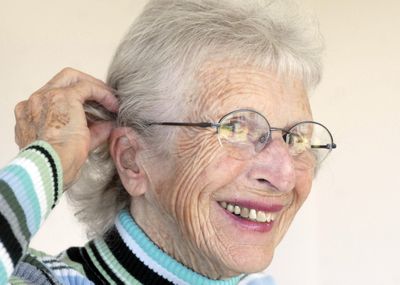Now everyone can listen up
Technology enhances hearing in large rooms

Korra and Omer Olson hadn’t attended homeowners association meetings at their Spokane Valley retirement community in several months for a simple reason: Both are hard of hearing and they couldn’t make out what people were saying.
That changed about three months ago when the community center at Good Samaritan Village installed an “induction loop” system. Basically, wire runs around the room’s perimeter, hidden behind crown molding, and connects to an amplified microphone. The system emits signals to specially equipped hearing aids, enabling users to hear clearly what’s being said. Korra Olson’s hearing aids are equipped with the tiny wires called telecoils, but her husband’s are not, so he spent $150 on a headset designed to work with the system.
“It was so good when he first used it that right away he asked if he could buy it,” said Korra Olson. “It’s almost too loud, but it’s really wonderful.”
The Good Samaritan community center is one of several buildings in Spokane County that recently have improved accessibility for people with hearing loss.
Perhaps most noteworthy: The Spokane County commissioners’ meeting room has been wired with an induction loop system similar to the one at Good Samaritan.
Audio Loop Solutions, of Spokane, which installed the systems at Good Samaritan and the commission hearing room, recently donated an induction loop system for use in a community meeting room at the Eastern Washington Center for the Deaf and Hard of Hearing. The state employment office in Spokane, WorkSource, recently purchased two portable systems for use by hearing-impaired clients.
And Columbia Hearing, of Spokane, in conjunction with a partner, recently donated a similar system for use by hearing-impaired patrons of the Spokane Civic Theatre that transmits sounds wirelessly.
“We’re just trying to get this room to where it’s more accommodating to all of our citizens,” said Spokane County spokeswoman Martha Lou Wheatley-Billeter of the improvement. She learned about the induction loop system during a presentation at the Eastern Washington Center for the Deaf and Hard of Hearing.
“What sold me was the look on their faces,” she said of the people in the audience. “Not only could they hear better, it was the clarity, that they could hear and understand more than they had been able to since they started using hearing aids.”
An estimated 10 percent of the population experiences some degree of hearing loss, according to the Eastern Washington Center. Public and commercial facilities are required by federal and state laws to provide reasonable accommodations to people with hearing loss. That means assistive listening devices should be provided when hard-of-hearing people attend public meetings, movies or symphony performances.
Conditions, however, frequently do not meet the requirements of the law, say hard-of-hearing residents in Spokane County. And even if businesses or public venues have the technology, patrons often don’t know it’s available because no signs are posted.
“Agencies think they’ve done what they should because they’ve purchased some assistive listening devices,” said Jan Doherty, former co-chairwoman of the Spokane chapter of the Hearing Loss Association of America and a public education officer for the Spokane Fire Department. “What they don’t realize is they could make their whole place accessible.”
Doherty said she sees that beginning to change but also thinks it’s “way past due.”
“Hearing loss is often invisible to the community,” she adds. “Unless you are impacted by that, you’re not conscious at all of how difficult it is to go about your business and be welcomed into social situations that other people take for granted. People that do not have a hearing loss think if you crank up the microphone, everyone is covered. That’s not so.”
As a result, people with hearing loss end up isolated, said Margaret Mortz, current co-chairwoman of the Hearing Loss Association’s Spokane chapter. “There’s nothing new about this technology, but the country is behind the curveball.”
Mortz said Europe is ahead of the United States in both making the technology available and making residents aware it’s there.
She attended a conference in the Netherlands in 1979 in a large auditorium, the type of place in which it’s usually difficult to hear, she said. She accidentally hit a switch on her hearing aids that activated her telecoil.
“I could hear clearly!” she wrote in an e-mail. “The whole auditorium was looped. Much of Europe has built hearing accessibility into their building codes, unlike the U.S.”
Mortz said induction loops generally are more cost-effective when a large number of people need assistance. If only one person does, a personal system might be more appropriate, she said, adding that she’d like to see more hearing aid dispensers educate customers about what’s available and what’s possible.
In Spokane County, most movie theaters offer headsets and receivers for hearing-impaired patrons upon request. The Spokane Veterans Memorial Arena and Spokane Convention Center offer personal devices that pick up wireless signals and amplify them for patrons.
Essie Crowder, disability program navigator for WorkSource in Spokane, which recently made available two personal induction loop systems for clients, said she hopes to see the entire office wired.
“A system like this would be a great tool for employers,” said Crowder, whose parents were deaf. “More and more people are in need of this. It’s just amazing how far they’ve come. It’s not just a simple little hearing aid anymore.”